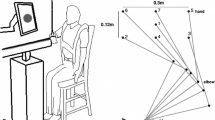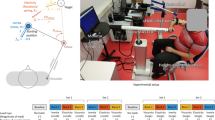Abstract
Studies have shown that the point-to-point reaching movements of subjects seated in a dark, rotating room demonstrate errors in movement trajectories and endpoints, consistent with the direction of the Coriolis force perturbations created by room rotation. Adaptation of successive reaches and the presence of postrotation aftereffects have indicated that subjects form internal models of the Coriolis field dynamics in order to make appropriate movement corrections. It has been argued that these findings are inconsistent with predictions of peripheral stabilization assumed in equilibrium-point models of motor control. A possibility that has been raised, however, is that the Coriolis field findings may in fact stem from changes in control commands elicited due to the magnitude and destabilizing nature of the Coriolis perturbations. That is, it has been suggested that a perturbation threshold exists, below which central reactions are not necessary in order to maintain movement stability. We tested the existence of a perturbation threshold in normal-speed reaching movements. Twelve normal human subjects performed non-visually guided reaching movements while grasping a robotic manipulandum. The endpoints and trajectory deviations of their movements were measured before, during, and after a position-dependent force field (similar to a Coriolis field in terms of the time history of applied forces) was applied to their movements. We examined the responses to a range of perturbation field strengths from small to considerable. Our experimental results demonstrated a substantial adaptation response over the entire range of perturbation field magnitudes examined. Neither the amount of adaptation after 5 trials nor after 25 trials was found to change as disturbance magnitudes decreased. These findings indicate that there is an adaptive response even for small perturbations; i.e., threshold behavior was not found. This result contradicts the assertion that peripheral stabilization mechanisms enable the central controller to ignore small details of peripheral or environmental dynamics. Our findings instead point to a central dynamic modeler that is both highly sensitive and continually active. The results of our study also showed that subjects were able to maintain baseline pointing accuracies despite exposure to perturbation forces of sizeable magnitude (more than 7 N).






Similar content being viewed by others
References
Boessenkool JJ, Nijhof E-J, Erkelens CJ (1998) A comparison of curvatures of left and right hand movements in a simple pointing task. Exp Brain Res 120:369–376
Burdet E, Osu R, Franklin DW, Milner TE, Kawato M (2001) The central nervous system stabilizes unstable dynamics by learning optimal impedance. Nature 414:446–449
Bhushan N, Shadmehr R (1999) Computational nature of human adaptive control during learning of reaching movements in force fields. Biol Cybern 81:39–60
Conditt MA, Gandolfo F, Mussa-Ivaldi FA (1997) The motor system does not learn the dynamics of the arm by rote memorization of past experience. J Neurophysiol 78:554–560
Feldman AG, Ostry DJ, Levin MF, Gribble PL, Mitnitski AB (1998) Recent tests of the equilibrium-point hypothesis (± model). Mot Control 2:189–205
Flash T (1987) The control of hand equilibrium trajectories in multi-joint arm movements. Biol Cybern 57:257–274
Franklin DW, Osu R, Burdet E, Kawato, M, Milner TE (2003a) Adaptation to stable and unstable dynamics achieved by combined impedance control and inverse dynamics model. J Neurophysiol (In press)
Franklin DW, Osu R, Burdet E, Kawato M, Milner TE (2003b) Functional significance of stiffness in adaptation of multijoint arm movements to stable and unstable environments. Exp Brain Res 151:145–157
Goodbody SJ, Wolpert DM (1998) Temporal and amplitude generalization in motor learning. J Neurophysiol 79:1825–1838
Gribble PL, Ostry DJ (2000) Compensation for loads during arm movements using equilibrium-point control. Exp Brain Res 135:474–482
Gribble PL, Ostry DJ, Sanguineti V, Laboissiere R (1998) Are complex control signals required for human arm movement? J Neurophysiol 79:1409–1424
Hogan N (1985) The mechanics of multi-joint posture and movement control. Biol Cybern 52:315–331
Kelso JAS, Holt KG (1980) Exploring a vibratory systems analysis of human movement production. J Neurophysiol 43:1183–1196
Lackner JR, Dizio P (1994) Rapid adaptation to Coriolis force perturbations of arm trajectory. J Neurophysiol 72:299–313
Milner TE (2002) Adaptation to destabilizing dynamics by means of muscle cocontraction. Exp Brain Res 143:406–416
Milner TE, Cloutier C (1993) Compensation for mechanically unstable loading in voluntary wrist movement. Exp Brain Res 94:522–532
Scheidt RA, Dingwell JB, Mussa-Ivaldi FA (2001) Learning to move amid uncertainty. J Neurophysiol 86:971–985
Shadmehr R, Mussa-Ivaldi FA (1994) Adaptive representation of dynamics during learning of a motor task. J Neurosci 14:3208–3224
Takahashi CD, Scheidt RA, Reinkensmeyer DJ (2001) Impedance control and internal model formation when reaching in a randomly varying dynamical environment. J Neurophysiol 86:1047–1051
Thoroughman KA, Shadmehr R (1999) Electromyographic correlates of learning an internal model of reaching movements. J Neurosci 19:8573–8588
Throroughman KA, Shadmehr R (2000) Learning of action through adaptive combination of motor primitives. Nature 407:742–747
Wolpert DM, Ghahramani Z, Jordan MI (1995) An internal model for sensorimotor integration. Science 269:1880–1882
Acknowledgements
This study was completed as part of E.J.L.'s MASc degree at the University of British Columbia. Work was supported by a National Sciences and Engineering Research Council of Canada Postgraduate Scholarship A and a Graduate Student Scholarship from the British Columbia Advanced Systems Institute. The authors wish to thank David Franklin for providing an early version of Fig. 1.
Author information
Authors and Affiliations
Corresponding author
Rights and permissions
About this article
Cite this article
Lai, E.J., Hodgson, A.J. & Milner, T.E. Influence of interaction force levels on degree of motor adaptation in a stable dynamic force field. Exp Brain Res 153, 76–83 (2003). https://doi.org/10.1007/s00221-003-1584-4
Received:
Accepted:
Published:
Issue Date:
DOI: https://doi.org/10.1007/s00221-003-1584-4




